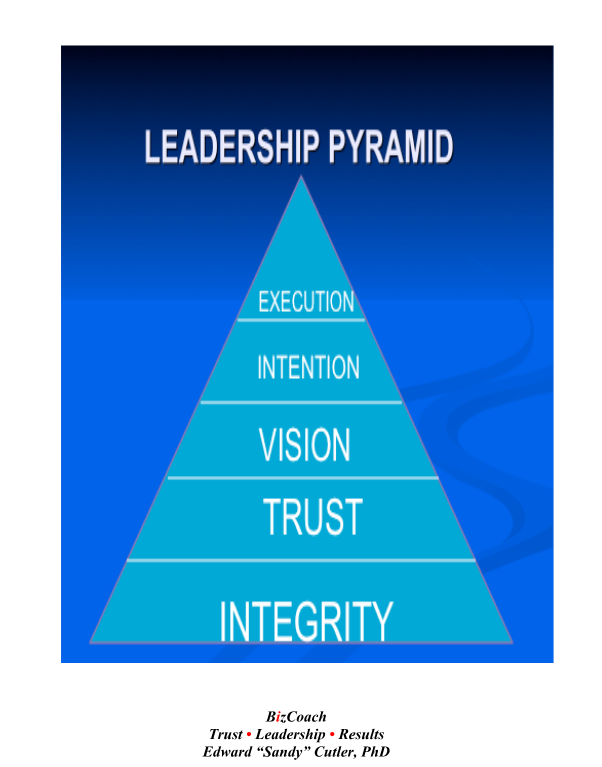TRUST is the second tier of the Leadership Pyramid. While doing research for my PhD, I discovered that the word “trust” was used most often to describe effective leaders. Dictionary.com defines trust as, “reliance on the integrity, strength, ability, surety, of a person or thing.” Note that this definition incorporates the word “integrity,” which is the foundation of the Leadership Pyramid. During many years of research and observation I’ve found that strong leaders are extremely effective in building trust with their peers, colleagues, subordinates, and other key stakeholders. Once trust has been established, almost anything becomes possible.

HOW TO BUILD TRUST
Edward “Sandy” Cutler, PhD
What does it mean to be trustworthy? Do you know someone who is trustworthy? What makes them trustworthy? Are you trustworthy? Can someone learn to become trustworthy? I’ve been exploring these questions for 34 years and have some conclusions. Being trustworthy is not easy. In fact, it can be extremely challenging. During the course of my original research I conducted over 150 interviews. As I read the transcripts of the interviews, I noticed the word trust was most often used to describe a “good” leader. Over the years I’ve continued to ask people to describe which behaviors help build trust and expanded my research to include both leaders and team members. My research reveals that the most effective leaders and team members demonstrate specific behaviors that make them trustworthy. Outlined below are ten behaviors of trustworthy people:
Honesty and integrity are the cornerstones for building trust. Leaders who are impeccably honest and consistently demonstrate integrity are the most trusted
People pay close attention to words and deeds. It’s important that your actions are congruent with your words. Statements consistent with actions build trust.
Everyone wants to be respected for who they are and for what they do. Treating everyone equally creates an atmosphere of trust. When people are treated equally and with respect, it reinforces feelings of individual self-worth and helps build a trusting relationship.
Every person wants to be heard and understood. The most successful leaders listen carefully and ask questions to elicit accurate and up-to-date information. Good interactive listening helps build trust.
Successful leaders are inclusive. They diligently include others in group decisions, actions, and activities. The most effective leaders actively interact and engage with others, which helps build trust.
Taking responsibility and acting responsibly demonstrates maturity and strong moral values. Leaders who act responsibly set a positive example for others, which leads to trusting relationships.
Successful leaders always seek new ideas. The most successful leaders consistently demonstrate individual initiative and they innovate. Taking the initiative and promoting new ideas helps create an environment that builds trust.
Most people want to be around someone who has a positive attitude and outlook on life. Leaders who are positive and upbeat are more respected and trusted than those who are negative.
The most successful leaders strive to develop their skills. Leaders who are lifelong learners demonstrate the ability to improve, which helps build trust.
The bottom line matters! Demonstrating a capacity to deliver results and to focus on outcomes (rather than activities) is an important behavior of the most trusted leaders.
What are my conclusions? Trust is like a bank account. When you demonstrate trustworthy behaviors, you make “deposits” into your personal trust account. When you ignore or disregard trustworthy behaviors, you make “withdrawals” from your personal trust account. Your deposits and withdrawals are cumulative. Therefore, your overall level of trust is the net sum of your trust deposits minus your trust withdrawals. Think about it as your trust quotient or “TQ.” You can learn to improve your TQ and build trust by paying close attention to the ten “trust-building” behaviors.
